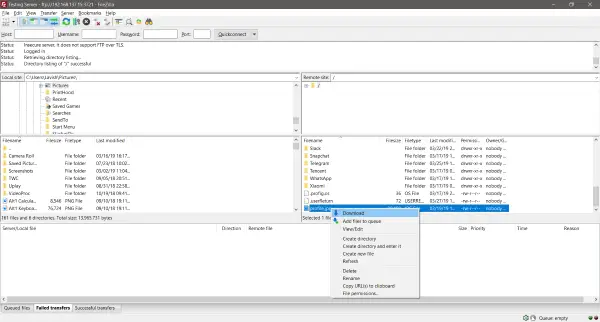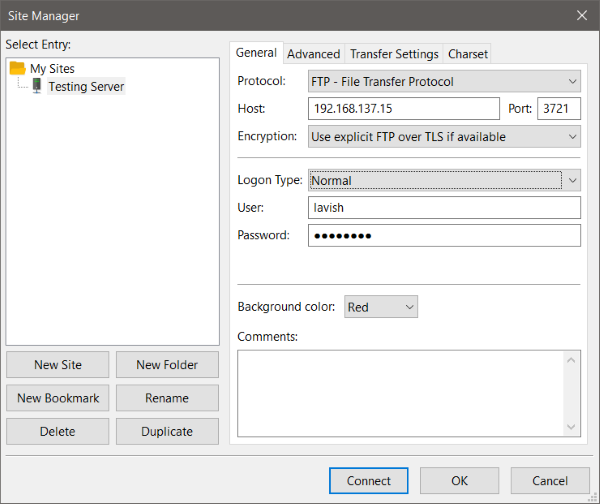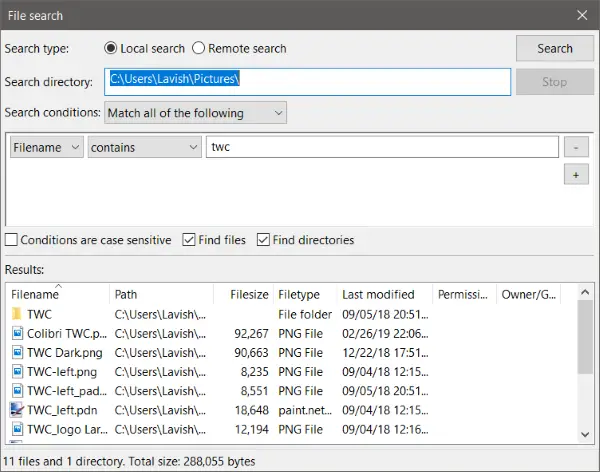FTP or File Transfer Protocol is a network protocol that is used to transfer files between a client and a server. It is quite an old way to transfer files, but it is very reliable and still in practice today. In this post, we are talking in detail about the most popular FTP client called FileZilla. FileZilla is the most popular, easy to use free FTP client available for all platforms including Windows, Linux, and MacOS. It can be used to connect to any FTP server, and the tool supports all variations of FTP.
FileZilla FTP software for Windows 11/10

The UI of this tool is what makes it popular and easy to use. If you click open FileZilla, you will notice a pretty neat UI divided into various rectangles or sections. Starting from top to bottom, you have the Menu bar followed by a Tool bar containing shortcuts to toggle some settings.
Next is the Quickconnect bar. The Quickconnect bar lets you quickly connect to a server without configuring many settings. You just need to enter hostname, username, password, and port. Quickconnect(s) are not preserved and are cleared automatically on next start-up.
Coming down, there is an entire section for Message Logs. This section records all the messages sent to or from the server. All the logs are displayed here, and it comes very handy in case of server failure or any other error.
Below that is the actual usable area, this section here is divided into two halves horizontally. The left one displays local directory tree, and the right one displays a remote directory tree. And just below the directory trees, the contents of a folder are displayed. You can drag and drop files across these sections to establish file transfer. Or you can right click any file/folder in the remote side and click on Download. Similarly, any file/folder can be clicked in the local side, and you can select Upload to send that file to a server.
The last section in the UI is the most powerful feature called Transfer Queue. When you download/upload any file from the server, it is added to this queue and is processed after all the files added before it is processed. This is a very efficient way of transferring files, and the queue makes sure that no file is omitted in the entire process. Also, there are separate tabs for Failed and Successful Transfers. If any of the file transfers have failed, you can quickly retry them.
FileZilla supports resume and transfer of large files which means that you can easily send large files over FileZilla client. Also, you can set a cap on transfer speeds so that FTP does not consume the connection’s entire bandwidth.
Read: How to set up Filezilla Server and Client.
FileZilla Site Manager
Site Manager is another one of the powerful features. It lets you store and configure all your FTP server settings in one place. It can open by pressing Ctrl + S from your keyboard. To create a new site, click on New Site. Now you can start entering the connection settings. You can select FTP/SFTP protocol from the dropdown. After that, you can configure the host’s IP address and FTP port number.

Moving on, encryption and authentication settings can also be configured. You can store your FTP passwords inside FileZilla, or you can configure it such that it prompts you every time for passwords. Under the Advanced tab, you can configure the server type although FileZilla can automatically detect it. You can configure proxy settings and change a few other advanced settings.
You can create as many sites inside the Site Manager. Plus you can also create multiple bookmarks inside a site. A bookmark is a record of a particular local and remote directory inside a side.
Tabs
Like any web browser, FileZilla lets you create as many tabs as you like. You can have multiple connections running inside different tabs. To create a new tab, you can use conventional keyboard shortcuts like Ctrl + T.
Directory Comparison
If you have two similar folders on your local and remote server, you can use this tool to compare them and find their differences. This tool is very handy when you periodically take backups as it can help you identify the files that have changed. Once enabled, it will highlight all the files that are different in both the locations. The yellow color will indicate the file exists only on one side; green indicates that the highlighted file is newer than its unhighlighted counterpart and red indicates that the two file sizes are different. Directory comparison is a great feature if you maintain a copy of your files on a remote server or vice-versa.
Synchronized Browsing
This feature is also for tow similar directory structures. Synchronized Browsing will automatically change location in the remote side when you change location on the local side and vice versa. So, if you navigate inside a folder on the local side, you would be automatically navigated to the same folder in the remote side. Make sure the folder names and directory structure is similar before you use this feature.
File Search
FileZilla comes with a powerful recursive file search tool. It can be used to search files both locally and on a remote server. You can enter all the search terms and list all the conditions, and the tool would start looking for files recursively inside all folders. Search is very useful if you are particularly looking for a file. File Search can be opened from the binocular’s icon from the toolbar.

FileZilla is undoubtedly the best FTP client to this date. It is free, open source, simple to use and clean. There are a lot of handy features available here and there which improves the overall experience. Both FTP and FileZilla are quite old, and this is what makes them reliable. Also, the modern variations of FTP (SFTP, FTP over SSL/TLS) are more secure and supported by FileZilla.
You can download FileZilla from FileZilla-Project.org.
How FTP works?
FTP, or File Transfer Protocol, is a unique way to send files from one computer to another over the internet. If you have a file on your computer that you want to send to someone else, then you connect to a particular storage space on the internet called an FTP server; once authorized, you can upload files there. It is almost like accessing a local server that is password protected.
How do I FTP on Windows?
In Windows, you can use File Explorer to connect to an FTP server and transfer files. Open File Explorer, select “Add a network location,” and enter the FTP server address. You can choose to log in anonymously or provide login credentials. Once connected, the FTP server will appear as a network location in File Explorer. Post this, it will be like browsing another directory, but it may be a little slow and depends on your connection speed.
Leave a Reply